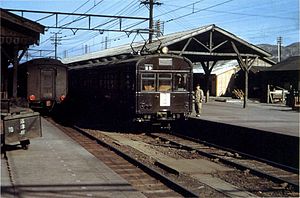
The 0 series trains were the first generation Shinkansen trainsets built to run on Japan's Tōkaidō Shinkansen high-speed line which opened in 1964. The last remaining trainsets were withdrawn in 2008.

The 300 series was a Japanese high-speed Shinkansen train type, with a top operational speed of 270 km/h, which operated on the Tokaido and Sanyo Shinkansen lines in Japan between 1992 and 2012. When first introduced, they were used on the fastest Nozomi services, being capable of 270 km/h (170 mph). As more were delivered they replaced earlier units on Hikari service and allowed the thus displaced 100 series units to finally in turn displace 0 series units on almost all services.

The Chuo Shinkansen is a Japanese maglev line under construction between Tokyo and Nagoya, with plans for extension to Osaka. Its initial section is between Shinagawa Station in Tokyo and Nagoya Station in Nagoya, with stations in Sagamihara, Kōfu, Iida and Nakatsugawa. The line is expected to connect Tokyo and Nagoya in 40 minutes, and eventually Tokyo and Osaka in 67 minutes, running at a maximum speed of 505 km/h (314 mph). About 90% of the 286-kilometer (178 mi) line to Nagoya will be tunnels.

The Class C62 (C62形) is a type of 4-6-4 steam locomotive designed by Hideo Shima and built by the Japanese National Railways (JNR). The "C" classification indicates three sets of driving wheels. The C62 was rebuilt with the boilers of older Class D52 2-8-2 locomotives.

The Railway Museum is a railway museum in Saitama, Saitama, Japan, which opened on 14 October 2007. It was built and is operated by the East Japan Railway Culture Foundation, a non-profit affiliate of the East Japan Railway Company. It consists of a 19,800 m² building on a site covering 42,500 m², with a display area 9,500 m² in size.

The Tsurumi Line is a group of 3 railway lines operated by East Japan Railway Company in Kanagawa Prefecture, Japan. Originally built to service the port and adjacent industrial area, the lines provide passenger services along a line between Tsurumi Station in Tsurumi-ku, Yokohama and Ōgimachi Station in Kawasaki-ku, Kawasaki, and 2 short branches with a total length of track to 9.7 km. The gauge is 1,067 mm, two sections of the line have double track and the line is electrified at 1,500 V DC.

The 80 series was an electric multiple unit (EMU) train type operated by Japanese National Railways (JNR) from 1950 until 1983. A total of 652 vehicles were built.

The 103 series is a DC electric multiple unit (EMU) commuter train type introduced in 1963 by Japanese National Railways (JNR), and currently operated by West Japan Railway Company and Kyushu Railway Company. They were also operated by East Japan Railway Company and Central Japan Railway Company.

The 117 series is a Japanese suburban electric multiple unit (EMU) train type introduced in 1979 by Japanese National Railways (JNR), and currently operated by West Japan Railway Company (JR-West). The train type was operated by Central Japan Railway Company from 1987 until 2013. A total of 216 cars were manufactured. When JNR was privatized and divided into the individual JR Group companies, JR Central received 72 cars, while JR-West took possession of 144.

The 113 series is a Japanese suburban electric multiple unit (EMU) train type introduced in 1963 by Japanese National Railways (JNR), currently operated by West Japan Railway Company (JR-West) and Shikoku Railway Company, and formerly also operated by East Japan Railway Company and Central Japan Railway Company.

The Sakuma Rail Park was an open-air railway museum located next to Chūbu-Tenryū Station on the Iida Line in Hamamatsu, Shizuoka, Japan. It was operated by Central Japan Railway Company, and was opened on 21 April 1991. The museum closed on 1 November 2009 in preparation for the move to a new SCMaglev and Railway Park in Nagoya in 2011.

The SCMaglev and Railway Park is a railway museum owned by Central Japan Railway Company in Nagoya, Japan. The museum opened on 14 March 2011.

The Kyoto Railway Museum is a railway museum in Shimogyō-ku, Kyoto, Japan. The original Umekoji Steam Locomotive Museum opened in 1972, but was expanded and modernized in 2016, becoming the Kyoto Railway Museum.

The 165 series was an express electric multiple unit (EMU) train type introduced in 1963 by Japanese National Railways (JNR).

The 52 series (52系) EMUs were manufactured in 1936-1937 in 3 batches and operated by Japanese Government Railways for use on the Hanwa Line, and later used on the San'yō Main Line, JR Kobe Line, JR Kyoto Line in the Kansai region and the Iida Line in Nagano Prefecture, Japan. The trains were developed from the 42 series EMUs.

"300X" was the name given to the Class 955 (955形) 6-car experimental Shinkansen train developed in 1994 by the Central Japan Railway Company in Japan to test technology to be incorporated in future shinkansen trains operating at speeds of 300 km/h (186 mph) or higher.

The L0 Series is a high-speed maglev train that the Central Japan Railway Company is developing and testing. JR Central plans to use the L0 series on the Chūō Shinkansen railway line between Tokyo and Osaka, which is under construction.

The 381 series is a tilting DC electric multiple unit (EMU) train type introduced in 1973 by Japanese National Railways (JNR), and currently operated by West Japan Railway Company (JR-West), and formerly also operated by Central Japan Railway Company in Japan.

The 301 series (301系) was an electric multiple unit (EMU) train type introduced in 1966 by Japanese National Railways (JNR), and later operated by East Japan Railway Company on Chuo-Sobu Line and Tozai Line subway through-running services in Tokyo, Japan, until 2003.

The KiHa 181 series was a diesel multiple unit (DMU) train type operated in Japan on limited express services between 1968 and 2010. Initially introduced by Japanese National Railways (JNR), the trains were later operated by West Japan Railway Company (JR-West) and Shikoku Railway Company following privatization in 1987.






















